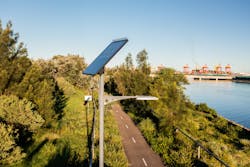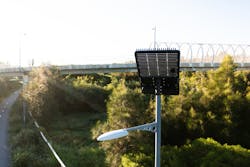OUTDOOR SSL | Best practices for solar street lighting systems
Street lighting represents about 20% of global lighting energy usage. The legacy streetlight system entirely relies on the grid for power, imposing a burden on the network during peak hours. Simultaneously, many public areas are devoid of sufficient nighttime illumination in developing cities that lack funding for infrastructure, including that needed to meet street and area lighting requirements for visibility and safety.
Solar street lighting can solve these problems. Grid-connected solar engines can feed existing streetlights during peak nighttime hours, reducing the burden on the electrical grid. In areas where accessing the electrical network is onerous, stand-alone solar exterior LED luminaires can provide an illuminated environment that enhances visual quality and public safety.
Solar lighting basics and benefits
The primary electrical components of a solar streetlight are a photovoltaic (PV) panel, rechargeable battery unit, LED light head typically between 20 and 100W, solar controller, and built-in or separate LED driver. The PV panel produces direct current (DC) electricity during the day, while the solar controller stores the generated electrical energy in the battery unit, with a typical capacity of 0.5 to 5kWh and potentially smaller if the light is outfitted with automated controls or dimming.
When the sun sets, the PV input voltage to the solar controller falls below a preset value, triggering the solar controller to discharge the battery through the integrated or remote LED driver (DC to DC). The connected LED light circuitry then illuminates the area until sunrise. The output is comparable to a conventional product; for example, a solar light with a 30W light head and three nights of autonomy — the number of nights a solar light can operate at a specified wattage with no or minimal sunlight availability during the day — will deliver the same output as that of a grid-connected LED light for that duration.
This is the general operating principle of solar lights available in the marketplace. However, the technology is in its infancy, and different manufacturers are adopting different product designs.
A solar lighting system offers several benefits, including ease of installation, cost savings, and energy savings. The installation is comparatively straightforward for stand-alone solar lights, which are available in two different categories: an all-in-one solar light package, which includes a PV panel, battery, controller, and LED light module; and a remote solar, or split, system, which has a remote PV or controller, battery, and a light head mounted onto the fixture’s arm. Neither of these types requires a mains connection with AC input or the related electrical wiring or cabling. While the overall overhead expense is less, the unit hardware cost is higher than that of most conventional lights.
For grid-connected solar lighting systems, the benefit is limited to the cost savings of electricity from the grid. Grid-tied solar lights are wired to the grid and operate similarly as a stand-alone solar streetlight for a specified period, say nighttime peak hours, or until the battery storage drops to a set value; the system then switches to grid power. They typically do not require huge battery storage or a large PV panel, which reduces the unit cost as compared to nongrid-connected, portable solar streetlights.
Like many renewable energy systems, the energy storage device plays a key role. Recent growth in this sector has led to robust rechargeable batteries and associated battery management systems. The solar lighting industry could leverage the growth in these technologies. The cost/kWh will also decrease as the renewable energy industry grows and batteries for electric vehicles (EVs) and similar applications are more broadly available. In 2010, the cost of Li-ion batteries was $1,200/kWh; by 2021, it was down 89%, to $132/kWh.
On a related point, solar streetlights are more reliable than EVs as the primary energy source for charging — sunlight — can be abundantly available* and is free throughout the year. For example, a 30W light head with three nights' autonomy in Sydney will need approximately a 160W PV panel and 1.5kWh battery. Moving closer to the equator, the PV panel and battery size requirement will decrease due to the consistent availability of solar energy year-round. Moving away from the equator, the panel size and battery requirements will increase.
Nevertheless, the road ahead for the solar street lighting industry is rocky. Technological challenges result in gray areas from a compliance perspective. The design process is detailed and complex; for simplicity, we will touch on the best practices for solar lighting system design, reliability, compliance, and maintainability.
Best practices begin with data
In Australia, government-employed engineers or consulting engineering firms hired by the agency typically oversee public projects, while consulting firms design private projects. Independent lighting contractors might step in to design the lighting layout, but not the overall electrical and lighting system.
To develop a solar street lighting system with optimal solar energy harvesting and use of stored electrical energy to maintain light levels and avoid noncompliance infractions**, the project team must design a balanced autonomous system based on several factors: the geographical location of the intended installation, a detailed historical study of solar irradiance in the area, and a compliant light level calculation.
Designers can research solar irradiance data from the National Solar Radiation Database and the National Renewable Energy Laboratory website; in Australia, the Bureau of the Meteorology website is a good reference. The Lighting Council of Australia’s Commercial Solar Lighting Guide is another helpful nonmandated guideline. The electrical standards, wiring rules, and lighting codes are to be used for general compliance. Additional reference documents may be needed depending on the project type.
Still, things can go wrong. When minimal sunlight availability due to unforeseen events — weather, cloud coverage — is followed by the consumption of stored energy at night, the result is a lower battery storage level. Here, the intelligent aspect of the solar controller system becomes helpful. If the battery storage level goes below a preset threshold, a built-in program or battery management system will reduce energy consumption based on a smart algorithm.
An anti-blackout setting is one way of circumventing a single-point failure that otherwise could lead to a nonrevivable flat battery. Simply put, this system monitors the battery storage and reduces the wattage of the light head to prevent the battery from running out of charge. For example, if the battery level is below 45%, the system cuts light output to 50%. If the battery level falls below 35%, light output is cut to 20%. When light output is dimmed to 20%, the battery can usually last another five to seven days without sunlight during the daytime.
Manufacturers can preprogram their products to different settings based on their application, usage, and battery type, among other factors. For example, Fonroche Lighting claims a proprietary Power 365 technology that ensures illumination 365 nights a year.
But operating the luminaire at 50% or 20% of the rated wattage reduces the light level and quality, with regard to technical requirements. However, the anti-blackout system is usually triggered after an extreme weather event, which would otherwise cause utility disruption and a complete blackout. Portable solar lights can be quite useful during severe floods or bushfires in terms of response and recovery when compared to their grid-connected counterparts.
For new solar lighting installations, designers can opt for an adaptive lighting scheme, where the light level is dimmed to the lower subcategory during off-peak hours, preprogrammed based on historical data regarding when traffic and pedestrian densities are comparatively low. This approach ensures compliance, optimal battery usage, and the longevity of solar streetlights. The implementation of adaptive lighting is not recommended for certain exterior applications, such as parking lots and pedestrian crossings. Adaptive lighting is a relatively new concept that has yet to be implemented at a large scale for major roads.
Maintenance and standards
Smart solar streetlights that communicate wirelessly as IoT edge devices offer real-time monitoring and fault detection to ease troubleshooting. Long-life batteries with up to 4,000 cycles (that is, more than 10 years of battery design life) can also reduce the streetlights’ overall failure rate. In addition, their modular plug-and-play design facilitates part replacement while mitigating other maintenance needs that may arise. Many early adopters of solar lights prefer a grid-backed system that can operate after an internal solar system failure. This is justifiable from a maintenance and compliance perspective, although a grid-tied system best suits LED retrofit projects that involve the one-to-one replacement of existing lights.
Still, because the technology is nascent, standards and regulations do not yet exist for solar lighting product safety and design compliance. In Australia, various organizations, such as the Australia Lighting Council, roadway lighting authorities, and local government agencies offer guidelines, but customers must often rely on the expertise of the specifier, manufacturer, and installer. The effectiveness and efficiency of a solar lighting solution heavily depend upon the best practices adopted by the solution providers.
Often, suppliers and designers will offer different product solutions for the same application, while still complying with existing electrical lighting standards and regulations. For example, manufacturers and suppliers might use a different duration of night for the autonomy calculation. Some use 11 or 12 hours; the best practice is to use the duration of night on the winter solstice at the intended installation site.
Manufacturers also assume a different maximum battery depth of discharge (DoD), or the maximum percentage of the battery that has been discharged relative to the overall capacity of the battery. The best practice is to use 80% DoD as the maximum when sizing equipment. However, some suppliers and lighting solution providers use 90%.
The autonomy and DoD assumed will affect the sizing of the PV panel and battery. So two different suppliers may recommend product solutions with different battery and PV panel ratings for the same application. Different manufacturers also use different battery types. Many solar lighting manufacturers, including Signify, use lithium-based batteries; Fonroche uses Ni-MH.
Because the technology is nascent, surge arrestors or lightning protection devices are not guaranteed to be included with a solar streetlight. IEC 60598 references surge protection devices (SPDs) and should be applicable to most luminaire types, including solar streetlights. Because these low-voltage lights typically are not grid-connected, many customers or end users assume they do not require an SPD and do not usually specify one. However, lightning does not differentiate and a strike would certainly damage a solar streetlight and associated cabling.
Solar lighting case study
In Port Botany, Australia, within the Greater Sydney region, the NSW Port Authority wanted to upgrade existing solar lights and PV panels on 81 poles to improve light levels along a 2km stretch and increase battery autonomy. The NSW Port Authority mandated that the lighting design needed to comply with the following standards:
- CASA Manual of Standards Part 139 – Chapter 12 Section 9.144 Zones A, B, C & D for obtrusive lighting in proximity to the airport runway.
- AS1158.3.1:2020 Table 3.4 PP3 for Pathways and Cycleways.
- AS4282:2019 for Obtrusive Lighting.
The 5.5-m-tall poles were fitted with Tigerlight Mako fittings programmed to 20W lamp power. Each luminaire has a SOLO solar engine with 160W bi-facial PV panels and a 130Ah battery. Tigerlight technical sales engineer Pieter Viviers specified Type II Medium optical lenses for the light head to maximize the light spread between poles. The SOLO solar engines are fully programmable and can adjust the paired lamp’s output to maximize autonomy in different solar conditions, including seasonal variations.
The output of the Mako lights and the 130Ah batteries in the SOLO engine were well matched to produce an autonomy of 4.5 days on a full charge. Excellent light levels and uniformity were achieved at 20m spacings, complying with the relevant lighting standards, CASA, and obtrusive lighting requirements.
Because the solar lighting market is relatively young, a qualified engineering consultant is essential to providing the requirements in the contract and specification documents. The consultant should have an in-depth understanding of the solar lighting system operation in real time. Clients should ask for a detailed project submittal that includes a solar irradiance study, lighting assessment, and design report as per relevant standards; datasheets and compliance certificates for significant parts; a lifespan and system warranty in writing; and a detailed operating and maintenance manual, including system preprogrammed settings.
NOTES
*Subjected to geographical location and seasonal conditions.
** Solar lights, like standard grid-connected luminaires, should deliver consistent power output as per the photometric test report from an accredited lab. Lighting design through software such as AGi32 or DIALux relies on the luminaire output to be that of its photometric file. Any variation in luminous flux or light distribution due to the lower capacity of the battery source is considered noncompliance.
*** Light technical parameters — Definitions:
Illuminance describes the amount of light falling on a given surface area.
Luminance is the amount of light reflected off a surface being illuminated.
Uniformity is a measure of how equally light is distributed on the illuminating surface.
JOHNSON PHILIP is an electrical engineer based in Sydney, Australia, who specializes in exterior and industrial lighting projects. He was actively involved in developing lighting solutions based on renewable sources such as solar for private and public domain lighting projects in the Oceania region. Philip has recently started working with City of Sydney as a senior engineer for electrical and lighting assets.
For up-to-the-minute LED and SSL updates, follow us on Twitter. You’ll find curated content and commentary, as well as information on industry events, webcasts, and surveys on our LinkedIn page and our Facebook page.
Johnson Philip | Electrical Engineer
JOHNSON PHILIP is an electrical engineer based in Sydney, Australia, who specializes in exterior and industrial lighting projects. He was actively involved in developing lighting solutions based on renewable sources such as solar for private and public domain lighting projects in the Oceania region. Philip has recently started working with City of Sydney as a senior engineer for electrical and lighting assets.










